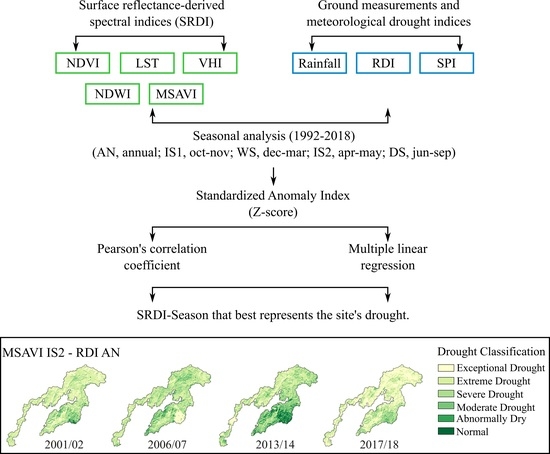Surface Reflectance–Derived Spectral Indices for Drought Detection: Application to the Guadalupe Valley Basin, Baja California, Mexico
Abstract
1. Introduction
2. Materials and Methods
2.1. Study Area
2.2. Meteorological–Based Drought Indices
2.3. Imagery Processing
2.4. Surface Reflectance–Derived Spectral Indices
2.5. Statistical Analyses
3. Results
3.1. Linking Climatic and Biophysical Parameters
3.2. Seasonal and Annual Correlations
3.3. Meteorological–Based and Surface Reflectance–Derived Drought Indices
3.4. Surface Reflectance–Derived Drought Assessment
4. Discussion
4.1. Seasonal and Annual Responses of NDVI to Precipitation and LST
4.2. Relationships between Surface Reflectance–Derived Spectral Indices and Meteorological Drought Indices
4.3. Surface Reflectance–Derived Spectral Indices and Climatic Variations
5. Conclusions
- (a)
- Both precipitation and LST factors affect the NDVI (positively/negatively), but stronger correlations revealed that precipitation is the primary seasonal control on NDVI across the hydrological seasons in the study area;
- (b)
- The VHI, NDWI, and MSAVI consistently showed stronger associations (R = 0.71–0.90) with meteorological drought indices (RDI AN, WS; SPI AN, WS) across almost all hydrological seasons (WS, IS2, DS, AN);
- (c)
- The strong correlations between VHI AN, NDWI IS2, and MSAVI IS2 with RDI AN and SPI AN suggest that this set of surface reflectance–derived spectral indices are the best predictors of meteorological drought in the GVB (Table 4);
- (d)
- The maps generated from MSAVI and NDWI in the GVB (Figure 5 and Figure 6) adequately reproduce the dry/wet periods in the region. For instance, the worst dry years that affected the GVB area were 2017/18 (99%), 2001/02 (97%), 2006/07 (96%), and 2013/14 (87%), and coincided with extreme drought periods documented in the literature.
Author Contributions
Funding
Institutional Review Board Statement
Informed Consent Statement
Data Availability Statement
Acknowledgments
Conflicts of Interest
References
- Tsakiris, G.; Pangalou, D. Drought Characterisation in the Mediterranean. In Coping with Drought Risk in Agriculture and Water Supply Systems; Iglesias, A., Cancelliere, A., Wilhite, D.A., Garrote, L., Cubillo, F., Eds.; Springer: Dordrecht, The Netherlands, 2009; Volume 26, pp. 69–80. [Google Scholar]
- Mishra, A.K.; Singh, V.P. A Review of Drought Concepts. J. Hydrol. 2010, 391, 202–216. [Google Scholar] [CrossRef]
- Dai, A. Drought under Global Warming: A Review: Drought under Global Warming. WIREs Clim. Chang. 2011, 2, 45–65. [Google Scholar] [CrossRef]
- Wilhite, D.A.; Svoboda, M.D.; Hayes, M.J. Understanding the Complex Impacts of Drought: A Key to Enhancing Drought Mitigation and Preparedness. Water Resour. Manag. 2007, 21, 763–774. [Google Scholar] [CrossRef]
- Riebsame, W.E. Drought and Natural Resources Management in the United States: Impacts and Implications of the 1987–89 Drought; Routledge: New York, NY, USA, 2020. [Google Scholar]
- Jain, S.K.; Keshri, R.; Goswami, A.; Sarkar, A. Application of Meteorological and Vegetation Indices for Evaluation of Drought Impact: A Case Study for Rajasthan, India. Nat. Hazards 2010, 54, 643–656. [Google Scholar] [CrossRef]
- McKee, T.B.; Doesken, N.J.; Kleist, J. The Relationship of Drought Frequency and Duration to Time Scales. In Proceedings of the 8th Conference on Applied Climatology, Anaheim, CA, USA, 17–22 January 1993; Volume 17. [Google Scholar]
- Tsakiris, G.; Vangelis, H. Establishing a Drought Index Incorporating Evapotranspiration. Eur. Water 2005, 9, 3–11. [Google Scholar]
- Stagge, J.H.; Kohn, I.; Tallaksen, L.M.; Stahl, K. Modeling Drought Impact Occurrence Based on Meteorological Drought Indices in Europe. J. Hydrol. 2015, 530, 37–50. [Google Scholar] [CrossRef]
- Sheffield, J.; Wood, E.F.; Roderick, M.L. Little Change in Global Drought over the Past 60 Years. Nature 2012, 491, 435–438. [Google Scholar] [CrossRef]
- AghaKouchak, A.; Farahmand, A.; Melton, F.S.; Teixeira, J.; Anderson, M.C.; Wardlow, B.D.; Hain, C.R. Remote Sensing of Drought: Progress, Challenges and Opportunities: Remote Sensing of Drought. Rev. Geophys. 2015, 53, 452–480. [Google Scholar] [CrossRef]
- Del-Toro-Guerrero, F.J.; Kretzschmar, T. Precipitation-Temperature Variability and Drought Episodes in Northwest Baja California, México. J. Hydrol. Reg. Stud. 2020, 27, 100653. [Google Scholar] [CrossRef]
- Sandeep, P.; Obi Reddy, G.P.; Jegankumar, R.; Arun Kumar, K.C. Monitoring of Agricultural Drought in Semi-Arid Ecosystem of Peninsular India through Indices Derived from Time-Series CHIRPS and MODIS Datasets. Ecol. Indic. 2021, 121, 107033. [Google Scholar] [CrossRef]
- Bento, V.A.; Gouveia, C.M.; DaCamara, C.C.; Libonati, R.; Trigo, I.F. The Roles of NDVI and Land Surface Temperature When Using the Vegetation Health Index over Dry Regions. Glob. Planet. Chang. 2020, 190, 103198. [Google Scholar] [CrossRef]
- Groisman, P.; Knight, R.W. Prolonged Dry Episodes over the Conterminous United States: New Tendencies Emerging during the Last 40 Years. J. Clim. 2008, 21, 1850–1862. [Google Scholar] [CrossRef]
- Stahle, D.W.; Cook, E.R.; Díaz, J.V.; Fye, F.K.; Burnette, D.J.; Soto, R.A.; Seager, R.; Heim, R.R. Early 21st-Century Drought in Mexico. Eos Trans. Am. Geophys. Union 2009, 90, 86–90. [Google Scholar] [CrossRef]
- Thomas, T.; Jaiswal, R.K.; Galkate, R.V.; Nayak, T.R. Reconnaissance Drought Index Based Evaluation of Meteorological Drought Characteristics in Bundelkhand. Procedia Technol. 2016, 24, 23–30. [Google Scholar] [CrossRef]
- Zhang, Y.; Yao, Y.; Lin, Y.; Xiang, L. Satellite Characterization of Terrestrial Drought over Xinjiang Uygur Autonomous Region of China over Past Three Decades. Environ. Earth Sci. 2016, 75, 451. [Google Scholar] [CrossRef]
- Cunha, A.P.M.A.; Zeri, M.; Deusdará Leal, K.; Costa, L.; Cuartas, L.A.; Marengo, J.A.; Tomasella, J.; Vieira, R.M.; Barbosa, A.A.; Cunningham, C.; et al. Extreme Drought Events over Brazil from 2011 to 2019. Atmosphere 2019, 10, 642. [Google Scholar] [CrossRef]
- Khan, R.; Gilani, H.; Iqbal, N.; Shahid, I. Satellite-Based (2000–2015) Drought Hazard Assessment with Indices, Mapping, and Monitoring of Potohar Plateau, Punjab, Pakistan. Environ. Earth Sci. 2020, 79, 23. [Google Scholar] [CrossRef]
- Zhang, L.; Jiao, W.; Zhang, H.; Huang, C.; Tong, Q. Studying Drought Phenomena in the Continental United States in 2011 and 2012 Using Various Drought Indices. Remote Sens. Environ. 2017, 190, 96–106. [Google Scholar] [CrossRef]
- Karnieli, A.; Ohana-Levi, N.; Silver, M.; Paz-Kagan, T.; Panov, N.; Varghese, D.; Chrysoulakis, N.; Provenzale, A. Spatial and Seasonal Patterns in Vegetation Growth-Limiting Factors over Europe. Remote Sens. 2019, 11, 2406. [Google Scholar] [CrossRef]
- Tucker, C.J. Red and Photographic Infrared Linear Combinations for Monitoring Vegetation. Remote Sens. Environ. 1979, 8, 127–150. [Google Scholar] [CrossRef]
- Karnieli, A.; Bayasgalan, M.; Bayarjargal, Y.; Agam, N.; Khudulmur, S.; Tucker, C.J. Comments on the Use of the Vegetation Health Index over Mongolia. Int. J. Remote Sens. 2006, 27, 2017–2024. [Google Scholar] [CrossRef]
- Mildrexler, D.; Yang, Z.; Cohen, W.B.; Bell, D.M. A Forest Vulnerability Index Based on Drought and High Temperatures. Remote Sens. Environ. 2016, 173, 314–325. [Google Scholar] [CrossRef]
- Ali, S.; Henchiri, M.; Yao, F.; Zhang, J. Analysis of Vegetation Dynamics, Drought in Relation with Climate over South Asia from 1990 to 2011. Environ. Sci. Pollut. Res. 2019, 26, 11470–11481. [Google Scholar] [CrossRef]
- Kogan, F.N. Application of Vegetation Index and Brightness Temperature for Drought Detection. Adv. Space Res. 1995, 15, 91–100. [Google Scholar] [CrossRef]
- Wiegand, C.L.; Richardson, A.J.; Escobar, D.E.; Gerbermann, A.H. Vegetation Indices in Crop Assessments. Remote Sens. Environ. 1991, 35, 105–119. [Google Scholar] [CrossRef]
- Qi, J.; Chehbouni, A.; Huete, A.R.; Kerr, Y.H.; Sorooshian, S. A Modified Soil Adjusted Vegetation Index. Remote Sens. Environ. 1994, 48, 119–126. [Google Scholar] [CrossRef]
- Wei, H.; Wang, J.; Cheng, K.; Li, G.; Ochir, A.; Davaasuren, D.; Chonokhuu, S. Desertification Information Extraction Based on Feature Space Combinations on the Mongolian Plateau. Remote Sens. 2018, 10, 1614. [Google Scholar] [CrossRef]
- Gao, B. NDWI—A Normalized Difference Water Index for Remote Sensing of Vegetation Liquid Water from Space. Remote Sens. Environ. 1996, 58, 257–266. [Google Scholar] [CrossRef]
- Serrano, J.; Shahidian, S.; Marques da Silva, J. Evaluation of Normalized Difference Water Index as a Tool for Monitoring Pasture Seasonal and Inter-Annual Variability in a Mediterranean Agro-Silvo-Pastoral System. Water 2019, 11, 62. [Google Scholar] [CrossRef]
- Daesslé, L.W.; Mendoza-Espinosa, L.G.; Camacho-Ibar, V.F.; Rozier, W.; Morton, O.; Van Dorst, L.; Lugo-Ibarra, K.C.; Quintanilla-Montoya, A.L.; Rodríguez-Pinal, A. The Hydrogeochemistry of a Heavily Used Aquifer in the Mexican Wine-Producing Guadalupe Valley, Baja California. Environ. Geol. 2006, 51, 151–159. [Google Scholar] [CrossRef]
- García, E. Modifications to the Köppen Climate Classification System (In Spanish). Available online: http://www.publicaciones.igg.unam.mx/index.php/ig/catalog/view/83/82/251-1 (accessed on 20 April 2020).
- Cooper, W.S. The Broad-Sclerophyll Vegetation of California; An Ecological Study of the Chaparral and Its Related Communities; Cornegie Institution of Washington: Washington, DC, USA, 1922; p. 176. [Google Scholar]
- Westman, W.E. Xerie Mediterranean-Type Shrubland Associations of Alta and Baja California and the Community/Continuum Debate. Vegetatio 1983, 52, 3–19. [Google Scholar] [CrossRef]
- Geografía (INEGI), I.N. de E. y Relieve Eontinental. Available online: https://www.inegi.org.mx/temas/relieve/continental/ (accessed on 11 May 2021).
- Thornthwaite, C.W. An Approach toward a Rational Classification of Climate. Geogr. Rev. 1948, 38, 55–94. [Google Scholar] [CrossRef]
- Del Toro-Guerrero, F.; Vivoni, E.; Kretzschmar, T.; Bullock Runquist, S.; Vázquez-González, R. Variations in Soil Water Content, Infiltration and Potential Recharge at Three Sites in a Mediterranean Mountainous Region of Baja California, Mexico. Water 2018, 10, 1844. [Google Scholar] [CrossRef]
- EarthExplorer. Available online: https://earthexplorer.usgs.gov/ (accessed on 1 June 2021).
- QGIS Development Team. QGIS Geographic Information System. Open-Source Geospatial Foundation Project. 2019. Available online: http://qgis.osgeo.org (accessed on 20 March 2021).
- GRASS Development Team. Geographic Resources Analysis Support System (GRASS). Open Source Geospatial Foundation. 2017. Available online: http://grass.osgeo.org (accessed on 20 March 2021).
- Congedo, L. Semi-Automatic Classification Plugin Documentation. Release 2016, 4, 29. [Google Scholar] [CrossRef]
- Roy, D.P.; Kovalskyy, V.; Zhang, H.K.; Vermote, E.F.; Yan, L.; Kumar, S.S.; Egorov, A. Characterization of Landsat-7 to Landsat-8 Reflective Wavelength and Normalized Difference Vegetation Index Continuity. Remote Sens. Environ. 2016, 185, 57–70. [Google Scholar] [CrossRef] [PubMed]
- Van De Griend, A.A.; Owe, M. On the Relationship between Thermal Emissivity and the Normalized Difference Vegetation Index for Natural Surfaces. Int. J. Remote Sens. 1993, 14, 1119–1131. [Google Scholar] [CrossRef]
- Artis, D.A.; Carnahan, W.H. Survey of Emissivity Variability in Thermography of Urban Areas. Remote Sens. Environ. 1982, 12, 313–329. [Google Scholar] [CrossRef]
- Weng, Q.; Lu, D.; Schubring, J. Estimation of Land Surface Temperature–Vegetation Abundance Relationship for Urban Heat Island Studies. Remote Sens. Environ. 2004, 89, 467–483. [Google Scholar] [CrossRef]
- Moran, M.S.; Jackson, R.D.; Slater, P.N.; Teillet, P.M. Evaluation of Simplified Procedures for Retrieval of Land Surface Reflectance Factors from Satellite Sensor Output. Remote Sens. Environ. 1992, 41, 169–184. [Google Scholar] [CrossRef]
- Bhuiyan, C.; Singh, R.P.; Kogan, F.N. Monitoring Drought Dynamics in the Aravalli Region (India) Using Different Indices Based on Ground and Remote Sensing Data. Int. J. Appl. Earth Obs. Geoinf. 2006, 8, 289–302. [Google Scholar] [CrossRef]
- Karnieli, A.; Agam, N.; Pinker, R.T.; Anderson, M.; Imhoff, M.L.; Gutman, G.G.; Panov, N.; Goldberg, A. Use of NDVI and Land Surface Temperature for Drought Assessment: Merits and Limitations. J. Clim. 2010, 23, 618–633. [Google Scholar] [CrossRef]
- Chen, C.F.; Son, N.T.; Chen, C.R.; Chiang, S.H.; Chang, L.Y.; Valdez, M. Drought Monitoring in Cultivated Areas of Central America Using Multi-Temporal MODIS Data. Geomat. Nat. Hazards Risk 2017, 8, 402–417. [Google Scholar] [CrossRef]
- Kogan, F. Satellite-Observed Sensitivity of World Land Ecosystems to El Niño/La Niña. Remote Sens. Environ. 2000, 74, 445–462. [Google Scholar] [CrossRef]
- Huete, A.R. A Soil-Adjusted Vegetation Index (SAVI). Remote Sens. Environ. 1988, 25, 295–309. [Google Scholar] [CrossRef]
- Liu, Z.Y.; Huang, J.F.; Wu, X.H.; Dong, Y.P. Comparison of Vegetation Indices and Red-Edge Parameters for Estimating Grassland Cover from Canopy Reflectance Data. J. Integr. Plant Biol. 2007, 49, 299–306. [Google Scholar] [CrossRef]
- Liou, Y.A.; Mulualem, G.M. Spatio–Temporal Assessment of Drought in Ethiopia and the Impact of Recent Intense Droughts. Remote Sens. 2019, 11, 1828. [Google Scholar] [CrossRef]
- Peters, A.J.; Walter-Shea, E.A.; Ji, L.; Viña, A.; Hayes, M.; Svoboda, M.D. Drought monitoring with NDVI-based standardized vegetation index. Photogramm. Eng. Remote Sens. 2002, 68, 71–75. [Google Scholar]
- Gu, Y.; Brown, J.F.; Verdin, J.P.; Wardlow, B. A Five-Year Analysis of MODIS NDVI and NDWI for Grassland Drought Assessment over the Central Great Plains of the United States. Geophys. Res. Lett. 2007, 34, L06407. [Google Scholar] [CrossRef]
- Gidey, E.; Dikinya, O.; Sebego, R.; Segosebe, E.; Zenebe, A. Using Drought Indices to Model the Statistical Relationships Between Meteorological and Agricultural Drought in Raya and Its Environs, Northern Ethiopia. Earth Syst. Environ. 2018, 2, 265–279. [Google Scholar] [CrossRef]
- Wang, J.; Rich, P.M.; Price, K.P. Temporal Responses of NDVI to Precipitation and Temperature in the Central Great Plains, USA. Int. J. Remote Sens. 2003, 24, 2345–2364. [Google Scholar] [CrossRef]
- Suzuki, R.; Xu, J.; Motoya, K. Global Analyses of Satellite-Derived Vegetation Index Related to Climatological Wetness and Warmth. Int. J. Climatol. 2006, 26, 425–438. [Google Scholar] [CrossRef]
- Chuai, X.W.; Huang, X.J.; Wang, W.J.; Bao, G. NDVI, Temperature and Precipitation Changes and Their Relationships with Different Vegetation Types during 1998–2007 in Inner Mongolia, China: Changes in NDVI, Temperature and Precipitation in Inner Mongolia. Int. J. Climatol. 2013, 33, 1696–1706. [Google Scholar] [CrossRef]
- Miao, L.; Jiang, C.; Xue, B.; Liu, Q.; He, B.; Nath, R.; Cui, X. Vegetation Dynamics and Factor Analysis in Arid and Semi-Arid Inner Mongolia. Environ. Earth Sci. 2015, 73, 2343–2352. [Google Scholar] [CrossRef]
- Zhu, L.; Gong, H.; Dai, Z.; Xu, T.; Su, X. An Integrated Assessment of the Impact of Precipitation and Groundwater on Vegetation Growth in Arid and Semiarid Areas. Environ. Earth Sci. 2015, 74, 5009–5021. [Google Scholar] [CrossRef]
- Daham, A.; Han, D.; Rico-Ramirez, M.; Marsh, A. Analysis of NVDI Variability in Response to Precipitation and Air Temperature in Different Regions of Iraq, Using MODIS Vegetation Indices. Environ. Earth Sci. 2018, 77, 389. [Google Scholar] [CrossRef]
- Guha, S.; Govil, H.; Besoya, M. An Investigation on Seasonal Variability between LST and NDWI in an Urban Environment Using Landsat Satellite Data. Geomat. Nat. Hazards Risk 2020, 11, 1319–1345. [Google Scholar] [CrossRef]
- Nemani, R.R. Climate-Driven Increases in Global Terrestrial Net Primary Production from 1982 to 1999. Science 2003, 300, 1560–1563. [Google Scholar] [CrossRef]
- Julien, Y.; Sobrino, J.A. The Yearly Land Cover Dynamics (YLCD) Method: An Analysis of Global Vegetation from NDVI and LST Parameters. Remote Sens. Environ. 2009, 113, 329–334. [Google Scholar] [CrossRef]
- Xu, W.; Gu, S.; Zhao, X.; Xiao, J.; Tang, Y.; Fang, J.; Zhang, J.; Jiang, S. High Positive Correlation between Soil Temperature and NDVI from 1982 to 2006 in Alpine Meadow of the Three-River Source Region on the Qinghai-Tibetan Plateau. Int. J. Appl. Earth Obs. Geoinf. 2011, 13, 528–535. [Google Scholar] [CrossRef]
- Tariq, A.; Riaz, I.; Ahmad, Z.; Yang, B.; Amin, M.; Kausar, R.; Andleeb, S.; Farooqi, M.A.; Rafiq, M. Land Surface Temperature Relation with Normalized Satellite Indices for the Estimation of Spatio-Temporal Trends in Temperature among Various Land Use Land Cover Classes of an Arid Potohar Region Using Landsat Data. Environ. Earth Sci. 2020, 79, 40. [Google Scholar] [CrossRef]
- Choi, M.; Jacobs, J.M.; Anderson, M.C.; Bosch, D.D. Evaluation of Drought Indices via Remotely Sensed Data with Hydrological Variables. J. Hydrol. 2013, 476, 265–273. [Google Scholar] [CrossRef]
- Chang, S.; Chen, H.; Wu, B.; Nasanbat, E.; Yan, N.; Davdai, B. A Practical Satellite-Derived Vegetation Drought Index for Arid and Semi-Arid Grassland Drought Monitoring. Remote Sens. 2021, 13, 414. [Google Scholar] [CrossRef]
- Chang, S.; Wu, B.; Yan, N.; Davdai, B.; Nasanbat, E. Suitability Assessment of Satellite-Derived Drought Indices for Mongolian Grassland. Remote Sens. 2017, 9, 650. [Google Scholar] [CrossRef]
- Gu, Y.; Hunt, E.; Wardlow, B.; Basara, J.B.; Brown, J.F.; Verdin, J.P. Evaluation of MODIS NDVI and NDWI for Vegetation Drought Monitoring Using Oklahoma Mesonet Soil Moisture Data. Geophys. Res. Lett. 2008, 35, L22401. [Google Scholar] [CrossRef]
- Wu, Z.; Velasco, M.; McVay, J.; Middleton, B.; Vogel, J.; Dye, D.; Western Geographic Science Center, U.S. Geological Survey, United States. MODIS Derived Vegetation Index for Drought Detection on the San Carlos Apache Reservation. Int. J. Adv. Remote Sens. GIS 2016, 5, 1524–1538. [Google Scholar] [CrossRef][Green Version]
- Lu, L.; Kuenzer, C.; Wang, C.; Guo, H.; Li, Q. Evaluation of Three MODIS-Derived Vegetation Index Time Series for Dryland Vegetation Dynamics Monitoring. Remote Sens. 2015, 7, 7597–7614. [Google Scholar] [CrossRef]
- Mantua, N.J.; Hare, S.R. The Pacific Decadal Oscillation. J. Oceanogr. 2002, 58, 35–44. [Google Scholar] [CrossRef]
- Pavia, E.G.; Graef, F.; Reyes, J. PDO–ENSO Effects in the Climate of Mexico. J. Clim. 2006, 19, 6433–6438. [Google Scholar] [CrossRef]
- Higgins, R.W.; Silva, V.B.S.; Shi, W.; Larson, J. Relationships between Climate Variability and Fluctuations in Daily Precipitation over the United States. J. Clim. 2007, 20, 3561–3579. [Google Scholar] [CrossRef]
- Arriaga-Ramírez, S.; Cavazos, T. Regional Trends of Daily Precipitation Indices in Northwest Mexico and Southwest United States. J. Geophys. Res. 2010, 115, D14111. [Google Scholar] [CrossRef]
- National Oceanic and Atmospheric Administration (NOAA). Available online: https://psl.noaa.gov/enso/mei/ (accessed on 7 June 2021).
- Jacobsen, A.L.; Pratt, R.B.; Ewers, F.W.; Davis, S.D. Cavitation Resistance among 26 Chaparral Species of Southern California. Ecol. Monogr. 2007, 77, 99–115. [Google Scholar] [CrossRef]
- Robeson, S.M. Revisiting the Recent California Drought as an Extreme Value. Geophys. Res. Lett. 2015, 42, 6771–6779. [Google Scholar] [CrossRef]
- Diffenbaugh, N.S.; Swain, D.L.; Touma, D. Anthropogenic Warming Has Increased Drought Risk in California. Proc. Natl. Acad. Sci. USA 2015, 112, 3931–3936. [Google Scholar] [CrossRef] [PubMed]
- Quiroz, M.L. Reporte del Clima en México. 2018. Available online: https://smn.conagua.gob.mx/tools/DATA/Climatolog%C3%ADa/Diagn%C3%B3stico%20Atmosf%C3%A9rico/Reporte%20del%20Clima%20en%20M%C3%A9xico/Anual2018.pdf (accessed on 5 May 2020).
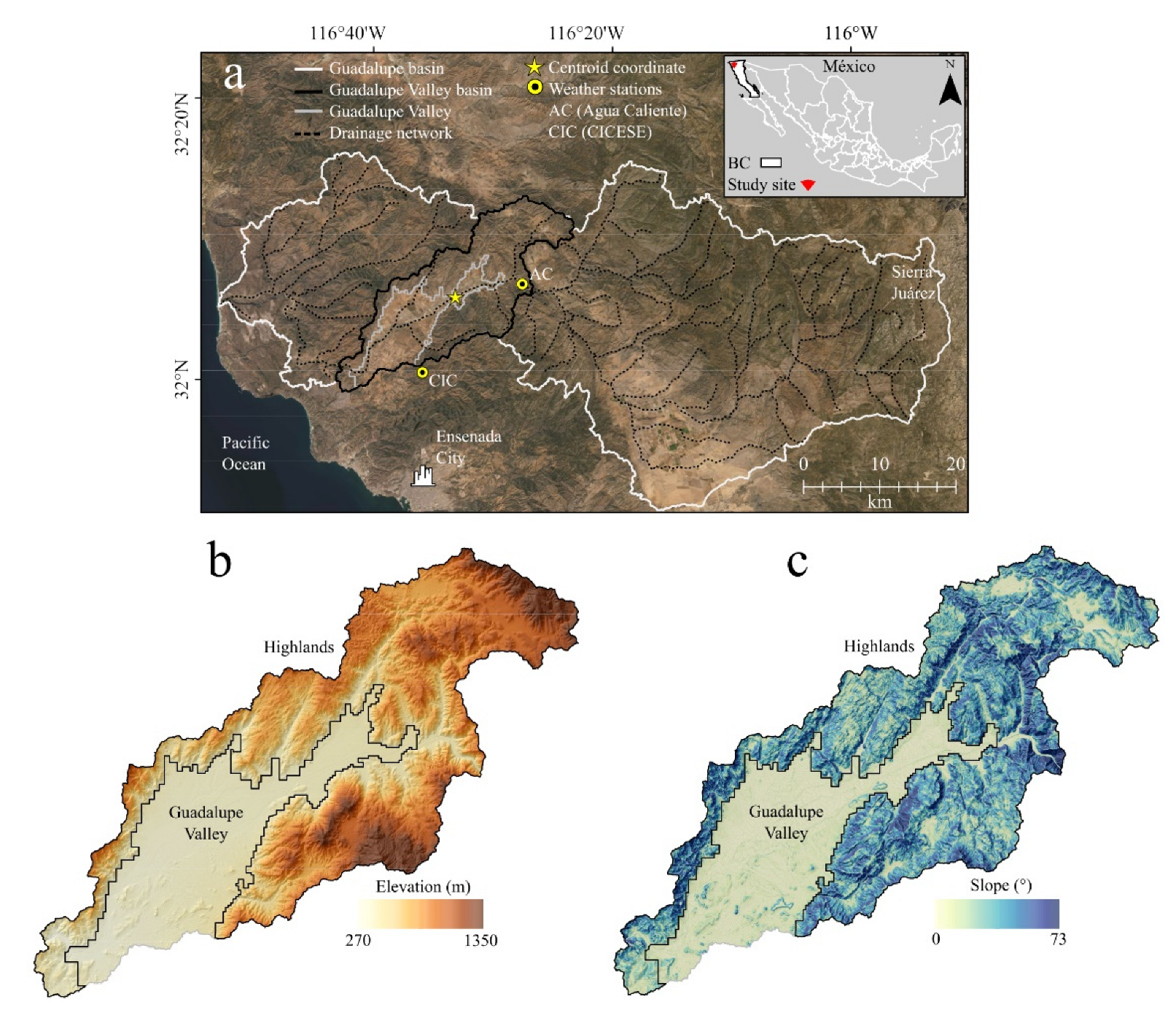
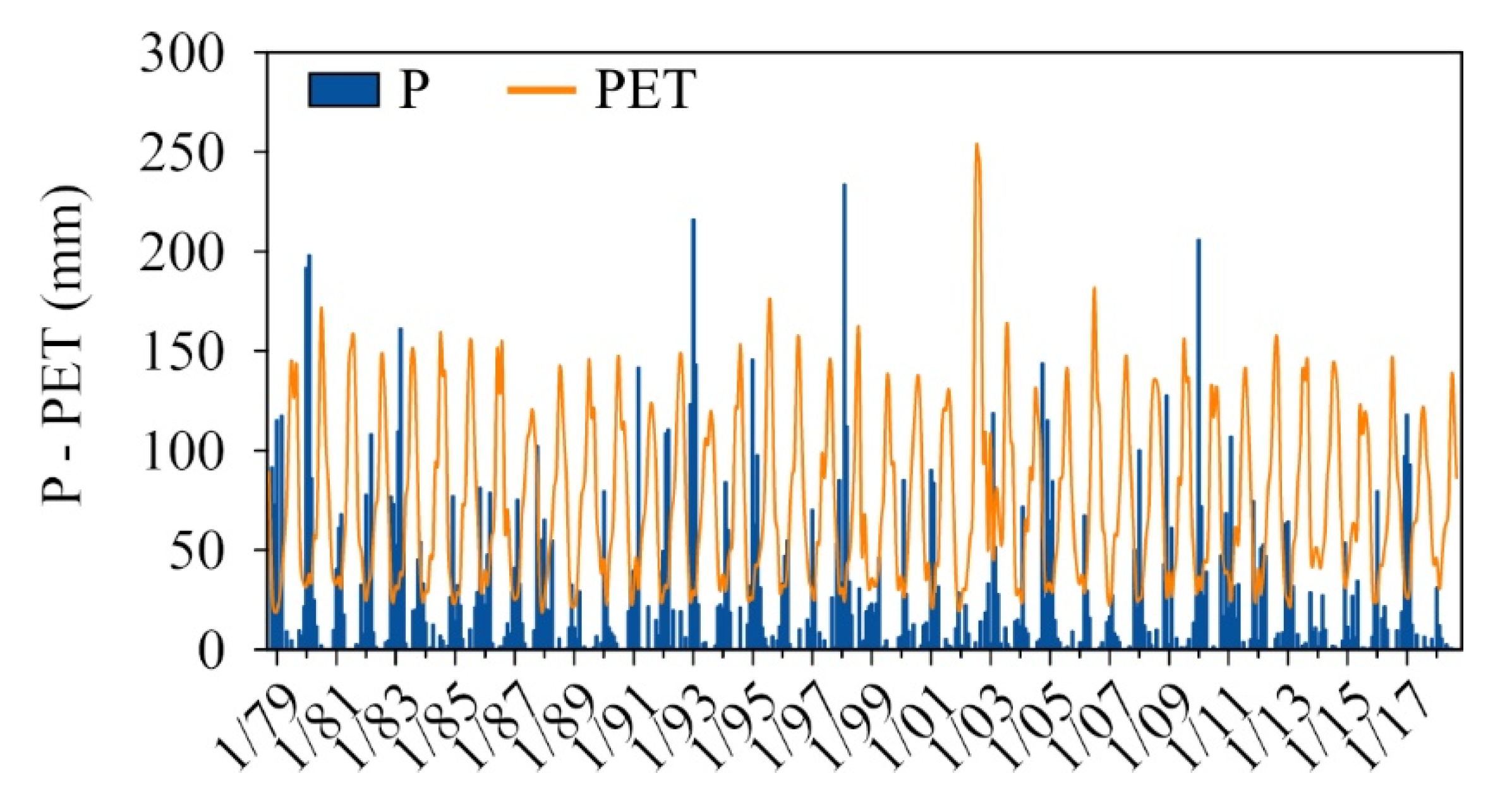


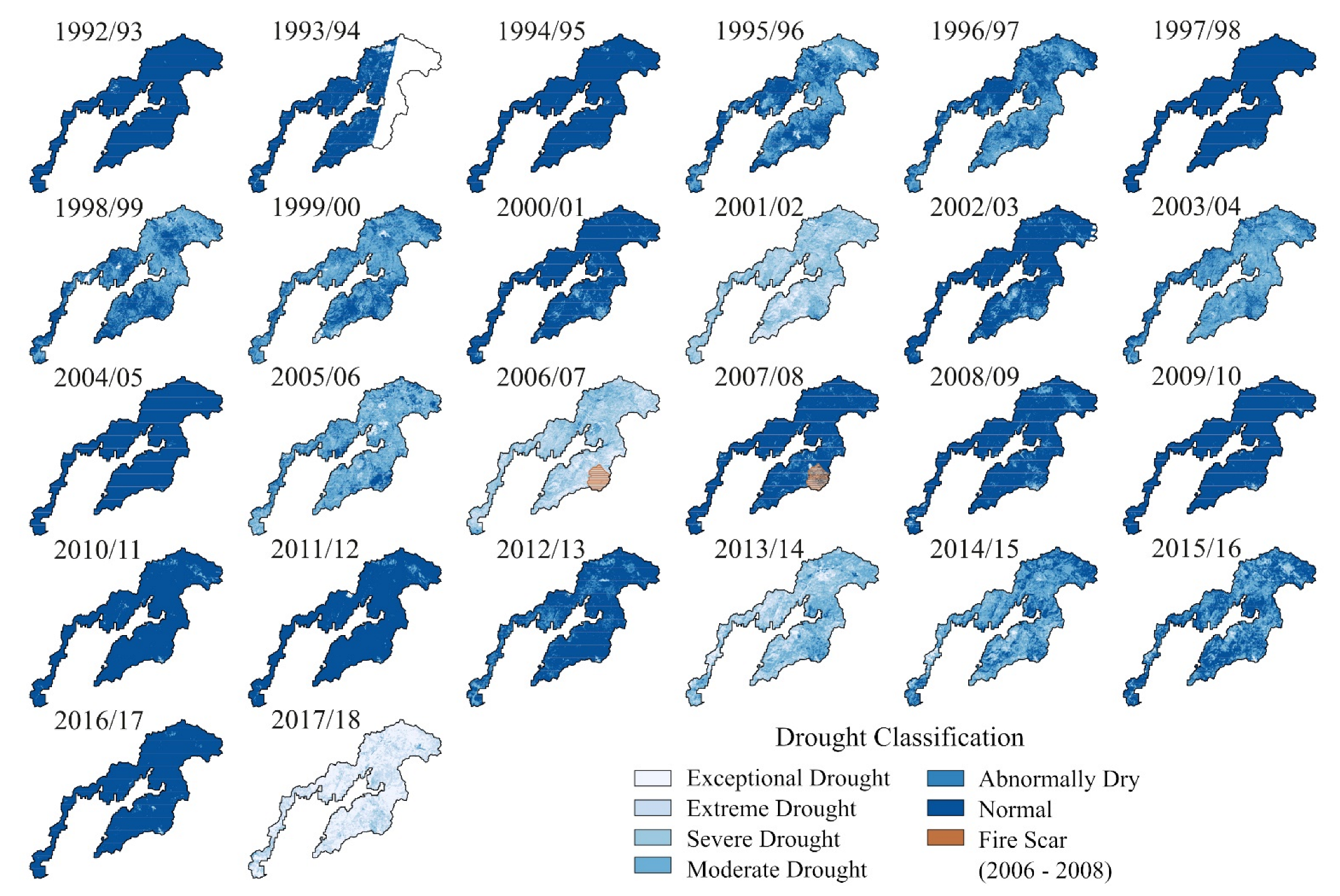
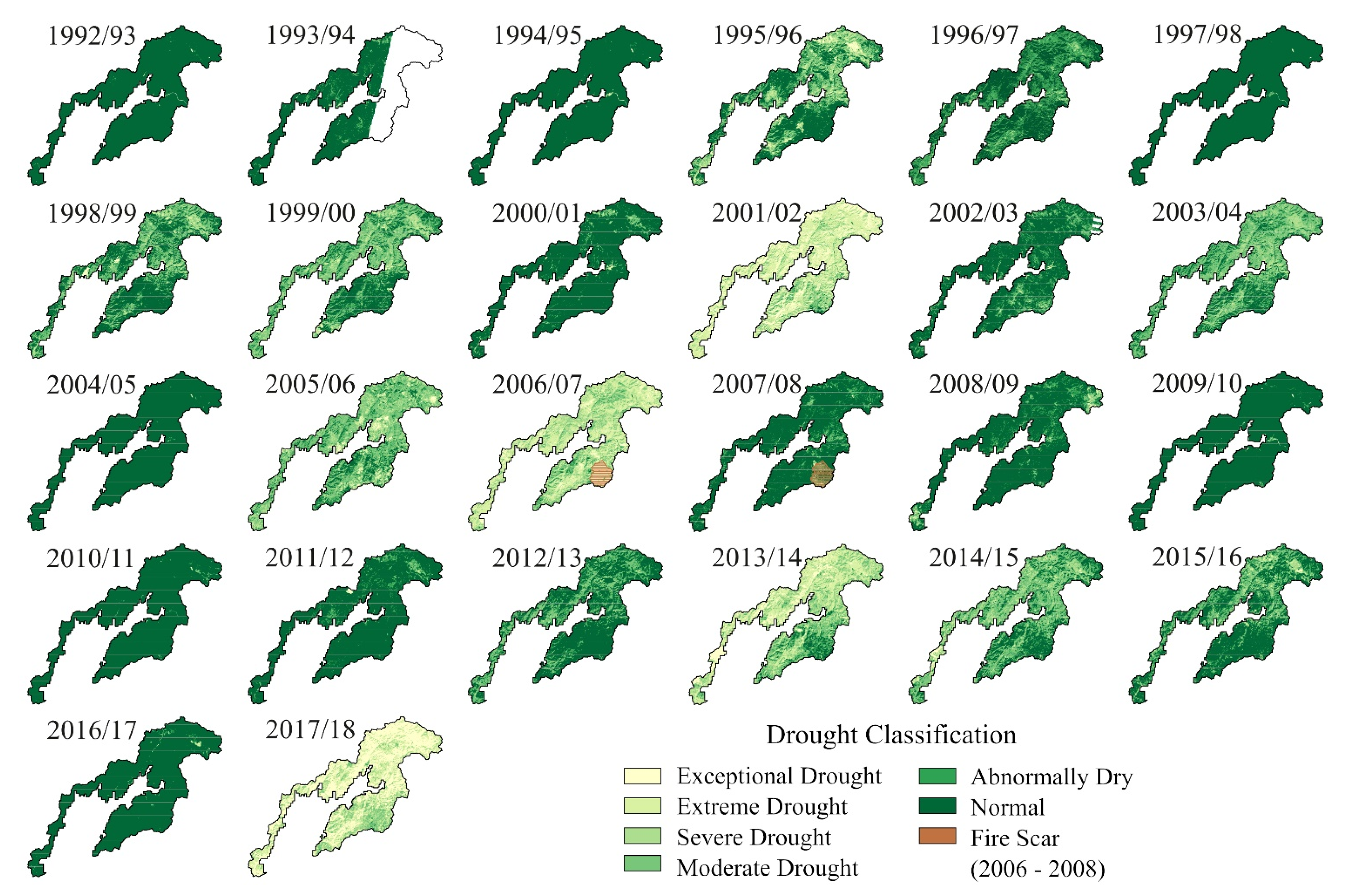

| Drought Classification | SPI |
|---|---|
| Normal (NOR) | >−0.5 |
| Abnormally dry (AD) | −0.5 to −0.8 |
| Moderate drought (MD) | −0.8 to −1.3 |
| Severe drought (SD) | −1.3 to −1.6 |
| Extreme drought (ED) | −1.6 to −2 |
| Exceptional drought (ExD) | <−2 |
| Image Conversion to Reflectance | Equation | Equation Notation | |
|---|---|---|---|
| Spectral Radiance at the Sensor’s Aperture (Lλ) [43] | (1) | ML = Multiplicative rescaling factor AL = Additive rescaling factor DN = Digital number d = Earth-Sun distance ESUNλ = Mean solar exo-atmospheric irradiance θs = Solar zenith angle Lp = Path radiance DNmin = Minimum DN value K1, K2 = Band specific thermal constants λ = Mean wavelength of emitted radiance c2 = h ∗ c/s (1.4388 ∗ 10−2 m K) h = Plank’s constant (6.626 ∗ 10−34 J s) s = Boltzmann constant (1.38 ∗ 10−23 J K) c = Velocity of light (2.998 ∗ 108 m s−1) | |
| Top of Atmosphere (TOA) Reflectance (ρp) [43] | (2) | ||
| Land Surface Reflectance (ρ) [43] | (3) | ||
| Atmospheric correction | Equation | ||
| Dark Object Subtraction Method (DOS1) [43,48] | (4) | ||
| Brightness conversion to Temperature | Equation | ||
| Satellite Brightness Temperature (TB) [43] | (5) | ||
| Land Surface Temperature (LST) [46] | (6) | ||
| Land Surface Emissivity (e) [45] | (7) | ||
| Surface reflectance vegetation index | Equation | ||
| Normalized Difference Vegetation Index (NDVI) [23] | (8) | ||
| P | P | LST | |||||||||||||||
|---|---|---|---|---|---|---|---|---|---|---|---|---|---|---|---|---|---|
| LST | IS1 | WS | IS2 | DS | AN | NDVI | IS1 | WS | IS2 | DS | AN | NDVI | IS1 | WS | IS2 | DS | AN |
| IS1 | −0.18 | −0.20 | −0.07 | −0.33 | −0.25 | IS1 | 0.07 | −0.03 | 0.00 | 0.47 | 0.02 | IS1 | −0.25 | −0.36 | −0.08 | −0.18 | −0.15 |
| WS | −0.28 | −0.82 | −0.17 | −0.28 | −0.82 | WS | 0.41 | 0.69 | 0.02 | 0.33 | 0.73 | WS | −0.51 | −0.24 | −0.54 | −0.32 | −0.33 |
| IS2 | −0.06 | −0.59 | −0.34 | −0.23 | −0.59 | IS2 | 0.20 | 0.78 | 0.28 | 0.31 | 0.78 | IS2 | −0.72 | −0.20 | −0.64 | −0.54 | −0.62 |
| DS | −0.01 | −0.59 | −0.47 | −0.37 | −0.60 | DS | 0.11 | 0.76 | 0.25 | 0.32 | 0.74 | DS | −0.68 | −0.26 | −0.59 | −0.49 | −0.63 |
| AN | −0.21 | −0.74 | −0.36 | −0.42 | −0.77 | AN | 0.28 | 0.79 | 0.17 | 0.40 | 0.81 | AN | −0.70 | −0.28 | −0.63 | −0.49 | −0.56 |
| Strong | Moderate | Weak | Negligible | ||||||||||||||
| NDVI | LST | VHI | |||||||||||||
|---|---|---|---|---|---|---|---|---|---|---|---|---|---|---|---|
| Seasons | AN | IS1 | WS | IS2 | DS | AN | IS1 | WS | IS2 | DS | AN | IS1 | WS | IS2 | DS |
| RDI AN | 0.80 | 0.00 | 0.73 | 0.79 | 0.73 | −0.78 | −0.26 | −0.83 | −0.59 | −0.60 | 0.86 | 0.19 | 0.86 | 0.81 | 0.75 |
| RDI IS1 | 0.33 | 0.17 | 0.41 | 0.24 | 0.18 | −0.26 | −0.23 | −0.33 | −0.11 | −0.08 | 0.33 | 0.25 | 0.43 | 0.22 | 0.17 |
| RDI WS | 0.80 | 0.01 | 0.73 | 0.77 | 0.74 | −0.74 | −0.26 | −0.79 | −0.55 | −0.54 | 0.84 | 0.19 | 0.85 | 0.78 | 0.74 |
| RDI IS2 | 0.10 | 0.00 | −0.03 | 0.22 | 0.16 | −0.38 | −0.14 | −0.16 | −0.40 | −0.45 | 0.21 | 0.09 | 0.04 | 0.32 | 0.27 |
| RDI DS | 0.40 | 0.31 | 0.33 | 0.36 | 0.35 | −0.45 | −0.37 | −0.35 | −0.19 | −0.40 | 0.45 | 0.42 | 0.37 | 0.33 | 0.39 |
| SPI AN | 0.78 | −0.03 | 0.72 | 0.77 | 0.71 | −0.77 | −0.26 | −0.82 | −0.58 | −0.60 | 0.84 | 0.17 | 0.84 | 0.79 | 0.74 |
| SPI IS1 | 0.31 | 0.12 | 0.40 | 0.23 | 0.17 | −0.23 | −0.16 | −0.32 | −0.09 | −0.09 | 0.30 | 0.17 | 0.42 | 0.20 | 0.16 |
| SPI WS | 0.78 | −0.09 | 0.69 | 0.77 | 0.74 | −0.76 | −0.20 | −0.82 | −0.59 | −0.61 | 0.83 | 0.10 | 0.83 | 0.80 | 0.76 |
| SPI IS2 | 0.09 | −0.04 | −0.05 | 0.22 | 0.16 | −0.36 | −0.11 | −0.16 | −0.37 | −0.43 | 0.20 | 0.06 | 0.02 | 0.31 | 0.26 |
| SPI DS | 0.36 | 0.34 | 0.30 | 0.29 | 0.30 | −0.41 | −0.41 | −0.30 | −0.16 | −0.35 | 0.40 | 0.46 | 0.33 | 0.27 | 0.34 |
| NDWI | MSAVI | Correlation level | |||||||||||||
| Seasons | AN | IS1 | WS | IS2 | DS | AN | IS1 | WS | IS2 | DS | |||||
| RDI AN | 0.82 | 0.15 | 0.75 | 0.88 | 0.68 | 0.88 | 0.03 | 0.67 | 0.90 | 0.84 | Very Strong | ||||
| RDI IS1 | 0.49 | 0.03 | 0.54 | 0.41 | 0.37 | 0.43 | 0.10 | 0.50 | 0.32 | 0.29 | Strong | ||||
| RDI WS | 0.74 | 0.17 | 0.67 | 0.83 | 0.60 | 0.87 | 0.05 | 0.66 | 0.87 | 0.83 | Moderate | ||||
| RDI IS2 | 0.30 | −0.07 | 0.19 | 0.30 | 0.44 | 0.15 | −0.12 | −0.01 | 0.24 | 0.26 | Weak | ||||
| RDI DS | 0.03 | −0.40 | −0.02 | 0.23 | 0.09 | 0.24 | −0.04 | 0.11 | 0.30 | 0.27 | Negligible | ||||
| SPI AN | 0.81 | 0.12 | 0.73 | 0.89 | 0.69 | 0.85 | −0.03 | 0.65 | 0.88 | 0.82 | |||||
| SPI IS1 | 0.50 | −0.01 | 0.54 | 0.42 | 0.39 | 0.42 | 0.04 | 0.49 | 0.32 | 0.28 | |||||
| SPI WS | 0.77 | 0.13 | 0.68 | 0.88 | 0.65 | 0.85 | −0.04 | 0.61 | 0.89 | 0.83 | |||||
| SPI IS2 | 0.27 | −0.08 | 0.17 | 0.28 | 0.41 | 0.14 | −0.17 | −0.02 | 0.24 | 0.25 | |||||
| SPI DS | −0.02 | −0.43 | −0.07 | 0.19 | 0.07 | 0.19 | −0.04 | 0.09 | 0.23 | 0.21 | |||||
| Variable | Multiple R | Adjusted R | Intercept (I) | Coefficient (C) | p-Values |
|---|---|---|---|---|---|
| VHI AN–RDI AN | 0.86 | 0.73 | −5.2862 | 12.7159 | 1.82 × 10−8 (I); 2.34 × 10−8 (C) |
| NDWI IS2–SPI AN | 0.89 | 0.79 | 0.9202 | 13.8414 | 1.52 × 10−6 (I); 1.07 × 10−9 (C) |
| MSAVI IS2–RDI AN | 0.90 | 0.81 | −3.9754 | 26.9899 | 2.27 × 10−10 (I); 2.74 × 10−10 (C) |
Publisher’s Note: MDPI stays neutral with regard to jurisdictional claims in published maps and institutional affiliations. |
© 2022 by the authors. Licensee MDPI, Basel, Switzerland. This article is an open access article distributed under the terms and conditions of the Creative Commons Attribution (CC BY) license (https://creativecommons.org/licenses/by/4.0/).
Share and Cite
Del-Toro-Guerrero, F.J.; Daesslé, L.W.; Méndez-Alonzo, R.; Kretzschmar, T. Surface Reflectance–Derived Spectral Indices for Drought Detection: Application to the Guadalupe Valley Basin, Baja California, Mexico. Land 2022, 11, 783. https://doi.org/10.3390/land11060783
Del-Toro-Guerrero FJ, Daesslé LW, Méndez-Alonzo R, Kretzschmar T. Surface Reflectance–Derived Spectral Indices for Drought Detection: Application to the Guadalupe Valley Basin, Baja California, Mexico. Land. 2022; 11(6):783. https://doi.org/10.3390/land11060783
Chicago/Turabian StyleDel-Toro-Guerrero, Francisco José, Luis Walter Daesslé, Rodrigo Méndez-Alonzo, and Thomas Kretzschmar. 2022. "Surface Reflectance–Derived Spectral Indices for Drought Detection: Application to the Guadalupe Valley Basin, Baja California, Mexico" Land 11, no. 6: 783. https://doi.org/10.3390/land11060783
APA StyleDel-Toro-Guerrero, F. J., Daesslé, L. W., Méndez-Alonzo, R., & Kretzschmar, T. (2022). Surface Reflectance–Derived Spectral Indices for Drought Detection: Application to the Guadalupe Valley Basin, Baja California, Mexico. Land, 11(6), 783. https://doi.org/10.3390/land11060783








